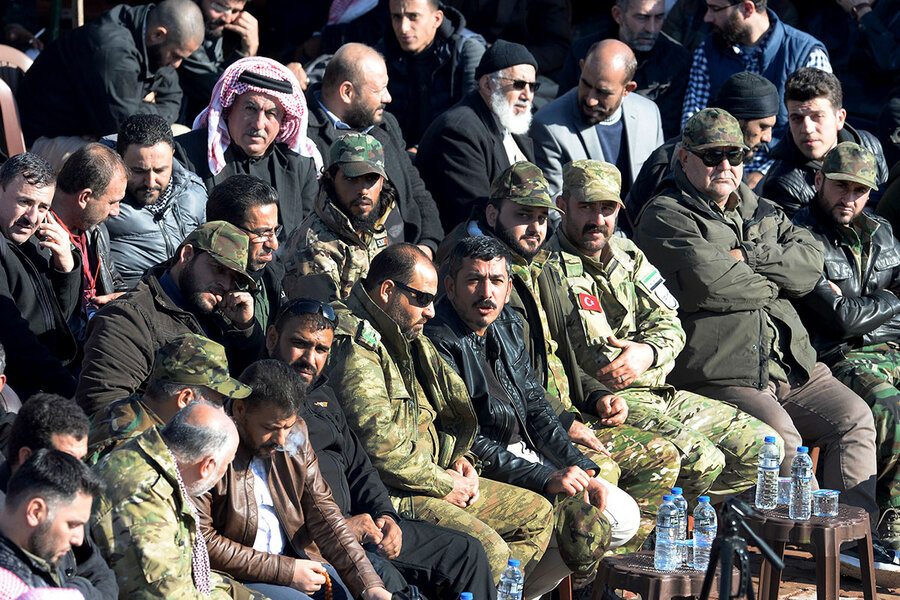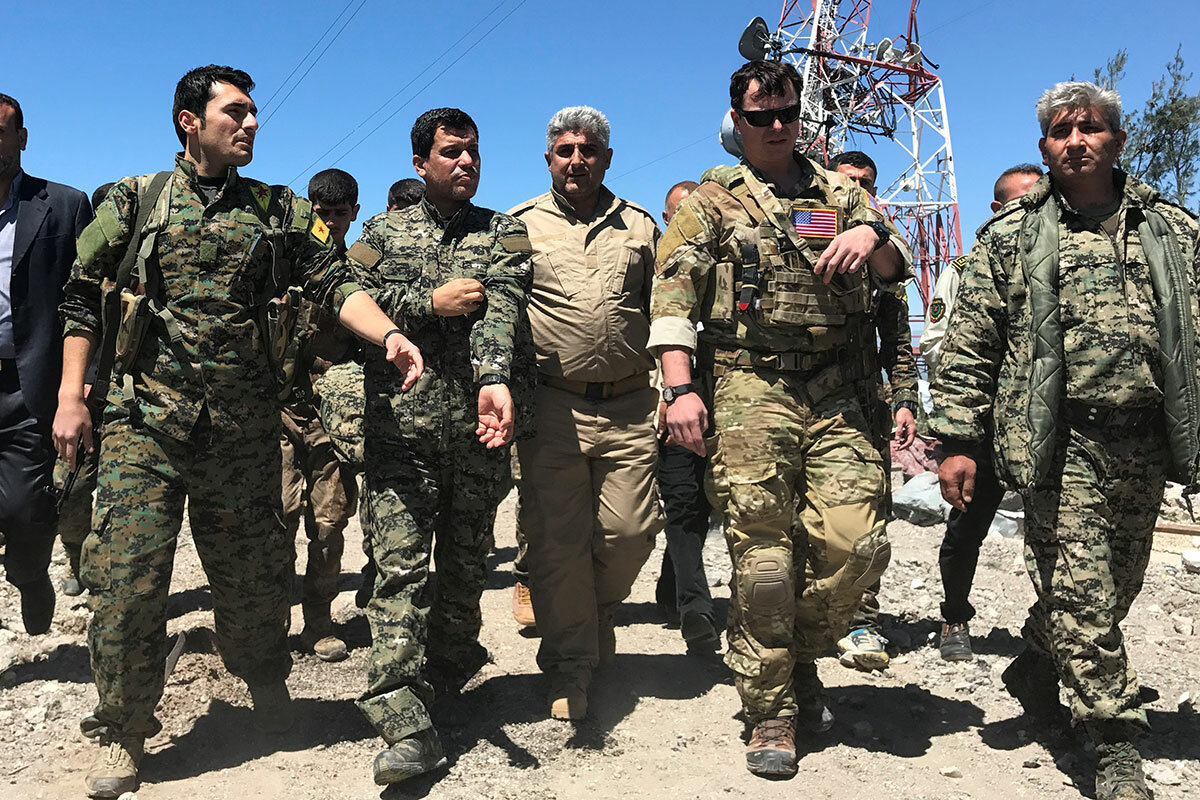How Trump’s announcement of a withdrawal reverberated across Syria
Loading...
For rebel fighters in Syria, where the United States nurtured local alliances with the goal of eradicating the Islamic State (ISIS), President Trump’s announcement of a rapid withdrawal of US troops was confusing and devastating. “People are petrified,” says one Syrian Arab rebel, who has been fighting with the Americans against ISIS near al-Tanf, in southeastern Syria. “How is the United States dropping us like that? We stood with them, and we were basically under their protection. Now we are at the mercy of the regime and the Russians.” US troops entered Syria for the first time in late 2015. What began as a deployment of 50 grew into an official total of about 2,000 tasked with bolstering the Syrian Democratic Forces, a coalition of Syrian Arab and Kurdish fighters fighting ISIS. Experts here say the withdrawal will result in a power vacuum and a major shift in the balance of power. Says Leyla, an aid worker with a local charity in a northern, Kurdish area: “There is a lot of confusion, fear and worry here about the security and political implications of this decision.... If the Syrian regime came back that would be a disaster.”
Why We Wrote This
How deep was the US commitment to its allies in Syria? That question has been asked all along. The Kurds and others knew President Trump favored a US withdrawal. Still, the timing came as a surprise.
When President Trump turned to Twitter to announce the imminent withdrawal of American troops from Syria, he triggered the resignation of two top United States defense officials and surprised foreign allies and adversaries alike.
For many Syrian opposition fighters who had allied themselves with the US forces on the ground, the reaction was both swift, and emotional.
“People are petrified,” says one Syrian Arab rebel, who has been fighting with the Americans against the Islamic State (ISIS) near al-Tanf, a strategic crossroads in southeastern Syria.
Why We Wrote This
How deep was the US commitment to its allies in Syria? That question has been asked all along. The Kurds and others knew President Trump favored a US withdrawal. Still, the timing came as a surprise.
“How is the United States dropping us like that?” asks the rebel, a local tribal leader who prefers to remain anonymous. “We stood with them, and we were basically under their protection. Now we are at the mercy of the regime and the Russians.”
For Kurds in Syria, where the United States nurtured local alliances with the goal of eradicating ISIS, the news was confusing and devastating.
“After four years focused on this region and after the establishment of bases in Syria, this decision comes as a surprise,” says Leyla, an aid worker with the local charity Civil Waves in the northeastern city of Qamishli on the Syrian border with Turkey. “The American decision to pull out troops will have negative consequences for Syrians in general and Kurds in particular.”
US troops entered Syria for the first time in late 2015. What began as a deployment of 50 grew into an official total of about 2,000. They built up the Syrian Democratic Forces, a coalition of Syrian Arab and Kurdish fighters, with the mission of terminating ISIS – although their presence also became a factor in efforts to contain Iran, which supports the regime.
“There is a lot of confusion, fear and worry here about the security and political implications of this decision,” adds Leyla. “People worry that World War III could get started if, for example, the Turks attack the region…. France said it will not drop the Kurds. Even if France is a great state, it is not that powerful.”
‘Syrians don’t want the regime’
The Kurdish area along Syria’s northern border has been beyond regime control for years.
In 2012, the Syrian regime pulled out of three mainly Kurdish inhabited areas of northern Syria. Two years later these regions rebranded themselves as de-facto autonomous cantons.
“If the Syrian regime came back that would be a disaster,” Leyla says. “After seven years of destroying the country and killing the people, what good can we expect to come of that? There will be arrests and more [human rights] violations. Syrians don't want the regime.”
Leyla has a son serving as a volunteer in the YPG – the (Kurdish) People’s Protection Units – a militia credited with being fierce frontline fighters and enabling major victories against ISIS, from the improbable defense of besieged Kobane in 2014 to the liberation of Raqqa, the capital of the so-called caliphate, which now lies in ruins.
The group is the dominant Kurdish force in northeast Syria and the backbone of the Syrian Democratic Forces – although it does not make up its majority in terms of numbers. In a televised interview, Mustafa Bali, the SDF spokesman, called Mr. Trump’s decision to withdraw from Syria shocking.
“It came as a surprise to us and even to the American forces here on the ground,” he said. “The war on terror is not over yet.”
The withdrawal, he warned, will cause a large void that will be exploited by terrorist forces, chief among them ISIS.
“They will try to use this void to regroup and launch counter-attacks,” he said. “This is a very unfortunate decision, which is not in keeping with the American commitments, or even with the commitments of the international coalition.”
Kurds’ focus is on Turkey
For Kurds in northeast Syria, however, the largest concern is not ISIS or its sleeper cells, but Turkey. Ankara views the US choice of partners as an existential threat at its doorstep – an offshoot of the Kurdish insurgency that has destabilized Turkey for decades. Turkey launched military operations in Syria in the summer of 2016 to flush out ISIS and the YPG.
In the Turkish-controlled Syrian town of Al-Bab, Arab fighters allied with Ankara display an appetite for battle. “There will be battles in Kobane, Tel Abyad, Manbij, Ras Al-Ayn, Qamishli,” predicts Khaldoun, a Syrian fighter who earns a monthly salary of 400 Turkish lira ($75), which is not enough to cover rent. “We support the Turks because we have been displaced from our areas by Kurds.”
He believes that Turkey and the Syrian regime will strike a deal whereby the regime takes the rebel-controlled enclave of Idlib, and Turkey with its allies will take Manbij and other areas of strategic interest to Turkey. “It’s obvious how things will play out,” he says, eager to return to the border town of Tel Abyad.
Syria’s Kurds are also in the market for a deal. Senior politicians of the Democratic Union Party (PYD), which played a major role in setting up the self-administrations in northern and eastern Syria, have been making the rounds in European capitals. They are also said to have sent representatives to talk with Iran, Russia, and the regime.
Kaniwar Hasan, whose work at the Qamishli-based Al-Furat Center for Studies focuses on Turkey, says that if a US withdrawal really materializes, the region of the East Euphrates will see a major shift in the balance of power.
“The Washington disavowal of its Syrian Democratic Forces and its allies opens up the door to new scenarios and alliances,” he says. “The most likely realistic scenario regarding the fate of the East Euphrates region is talks between Damascus and the SDF in order to fill the vacuum created by the United States and (neutralize) Turkish threats.”
Hawas Sadoun, a Kurdish member of a Syrian opposition coalition that has engaged periodically in United Nations-sponsored negotiations with the regime, says all the possible scenarios raised by the US withdrawal are alarming, including a resurgent ISIS or an emboldened Turkey or Iran.
“The patterns of the Syrian regime, Iran, and their affiliated militias are well known,” he says. “They subject those who have not succumbed to their policies and criminal plans to repression and revenge.… We’ve witnessed how the regime has treated the reconciled areas and how it jailed people and forced them to join its ranks, despite promising not to harm them.”
Resurgent ISIS
At the same time, he argues, the regime no longer possesses the military ability to prevent ISIS and other terrorists organizations from regrowing and regaining their influence.
“All these factors make the future frightening for the people of East Euphrates, especially the Kurds because of their vital role in fighting the terrorist organizations,” he says. “Anyone who has been following the statements of President Trump and the US administration could see that many of them were indicating a withdrawal, but the timing was a surprise, because it contradicted with many of the statements made by officials of the US administration.”
Only two days prior to Trump’s announcement, points out Mr. Sadoun, the special US envoy for Syria Engagement, James Jeffrey, had defined the objectives for the presence of US forces in Syria as follows: the elimination of ISIS, putting an end to Iran’s influence and expansion in Syria, and achieving a political solution that guarantees stability in Syria and the region.
“The decision to withdraw the forces came before achieving any of these goals,” notes Sadoun.
For the Syrian rebel fighter stationed near al-Tanf, the prospect of facing a resurgent ISIS fills him with foreboding, for himself and his family.
“As long as the US was present, we were not afraid,” he says. “Here I am not safe. What they don’t realize is that the next iteration of the Islamic State is going to be 10 times worse because the job is not done.”
The Americans “need to secure a way out for those who proved to be their allies on the ground,” he says. “I would work with them anywhere ... Afghanistan, Pakistan ... but I need my family to be safe.”








